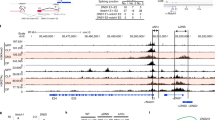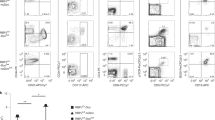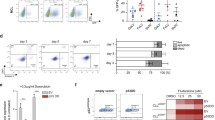Abstract
To examine the effects of Notch signaling on hematopoiesis, we transplanted mice with progenitors transduced with a constitutively active form of Notch1 (Notch1IC) or the Notch1 target genes Hes. Notch1IC-transduced cells induce T cell tumors and cannot generate B lymphocytes in vivo. Hes-transplanted mice remained healthy but cells transduced with Hes1 or Hes5 were partially impaired in their ability to differentiate into B cells. Both Hes1 and Hes5 were upregulated in the BM of Notch1IC mice and their ability to interfere with the transcriptional activity of E2A in a reporter assay was comparable to that of Notch1IC. This suggests that the inhibition of B cell development in the Notch1IC-transduced cells could be mediated by the interference of HES1/HES5 proteins with E2A. Hes1-, Hes5- and Notch1IC-transduced bone marrow cells cultured ex vivo in a colony forming assay in the presence of cytokines that promote myeloid differentiation remained very immature, indicating that the myeloid potential of these bone marrow cells was altered. Thymocytes overexpressing Hes1, Hes5 or Notch1IC matured normally into CD4 and CD8 single positive cells in vivo. Altogether our data suggest that Notch1IC induces T cell tumors independently of Hes genes but that its interference with lymphoid B and myeloid maturation is partly mediated by Hes1 and Hes5.
This is a preview of subscription content, access via your institution
Access options
Subscribe to this journal
Receive 50 print issues and online access
$259.00 per year
only $5.18 per issue
Buy this article
- Purchase on Springer Link
- Instant access to full article PDF
Prices may be subject to local taxes which are calculated during checkout





Similar content being viewed by others
References
Akazawa C, Ishibashi M, Shimizu C, Nakanishi S, Kageyama R . 1995 J. Biol. Chem. 270: 8730–8738
Akazawa C, Sasai Y, Nakanishi S, Kageyama R . 1992 J. Biol. Chem. 267: 21879–21885
Artavanis-Tsakonas S, Matsuno K, Fortini ME . 1995 Science 268: 225–232
Artavanis-Tsakonas S, Rand MD, Lake RJ . 1999 Science 284: 770–776
Aster JC, Xu L, Karnell FG, Patriub V, Pui JC, Pear WS . 2000 Mol. Cell. Biol. 20: 7505–7515
Bain G, Maandag EC, Izon DJ, Amsen D, Kruisbeek AM, Weintraub BC, Krop I, Schlissel MS, Feeney AJ, van Roon M, van der Valk M, te Riele HPJ, Berns A, Murre C . 1994 Cell 79: 885–892
Carlesso N, Aster JC, Sklar J, Scadden DT . 1999 Blood 93: 838–848
Condorelli GL, Tocci A, Botta R, Facchiano F, Testa U, Vitelli L, Valtieri M, Croce CM, Peschle C . 1997 Mol. Cell. Biol. 17: 2954–2969
Deftos ML, He YW, Ojala EW, Bevan MJ . 1998 Immunity 9: 777–786
Deftos ML, Huang E, Ojala EW, Forbush KA, Bevan MJ . 2000 Immunity 13: 73–84
Du C, Redner RL, Cooke MP, Lavau C . 1999 Blood 94: 793–802
Hardy RR, Carmack CE, Shinton SA, Kemp JD, Hayakawa K . 1991 J. Exp. Med. 173: 1213–1225
Hawley RG, Lieu FHL, Fong AZC, Hawley TS . 1994 Gene Therapy 1: 136–138
Hirata H, Ohtsuka T, Bessho Y, Kageyama R . 2000 J. Biol. Chem. 275: 19083–19089
Ishibashi M, Sasai Y, Nakanishi S, Kageyama R . 1993 Eur. J. Biochem. 215: 645–652
Jarriault S, Le Bail O, Hirsinger E, Pourquie O, Logeat F, Strong CF, Brou C, Seidah NG, Israel A . 1998 Mol. Cell. Biol. 18: 7423–7431
Kaneta M, Osawa M, Sudo K, Nakauchi H, Farr AG, Takahama Y . 2000 J. Immunol. 164: 256–264
Kawamata S, Hori T, Imura A, Takaori-Kondo A, Uchiyama T . 1998 J. Biol. Chem. 273: 5808–5814
Kim HK, Siu G . 1998 Mol. Cell. Biol. 18: 7166–7175
Koch U, Lacombe TA, Holland D, Bowman JL, Cohen BL, Egan SE, Guidos CJ . 2001 Immunity 15: 225–236
Lu FM, Lux SE . 1996 Proc. Natl. Acad. Sci. USA 93: 5663–5667
Massari ME, Murre C . 2000 Mol. Cell. Biol. 20: 429–440
McLarren KW, Lo R, Grbavec D, Thirunavukkarasu K, Karsenty G, Stifani S . 2000 J. Biol. Chem. 275: 530–538
Milner LA, Bigas A, Kopan R, Brashem-Stein C, Bernstein ID, Martin DI . 1996 Proc. Natl. Acad. Sci. USA 93: 13014–13019
Nishimura M, Isaka F, Ishibashi M, Tomita K, Tsuda H, Nakanishi S, Kageyama R . 1998 Genomics 49: 69–75
Ohtsuka T, Ishibashi M, Gradwohl G, Nakanishi S, Guillemot F, Kageyama R . 1999 EMBO J. 18: 2196–2207
Ordentlich P, Lin A, Shen CP, Blaumueller C, Matsuno K, Artavanis-Tsakonas S, Kadesch T . 1998 Mol. Cell. Biol. 18: 2230–2239
Osborne B, Miele L . 1999 Immunity 11: 653–663
Oswald F, Liptay S, Adler G, Schmid RM . 1998 Mol. Cell. Biol. 18: 2077–2088
Pear WS, Aster JC, Scott ML, Hasserjian RP, Soffer B, Sklar J, Baltimore D . 1996 J. Exp. Med. 183: 2283–2291
Pui JC, Allman D, Xu L, DeRocco S, Karnell FG, Bakkour S, Lee JY, Kadesch T, Hardy RR, Aster JC, Pear WS . 1999 Immunity 11: 299–308
Robey E, Chang D, Itano A, Cado D, Alexander H, Lans D, Weinmaster G, Salmon P . 1996 Cell 87: 483–492
Ross DA, Kadesch T . 2001 Mol. Cell. Biol. 21: 7537–7544
Schroeder T, Just U . 2000 EMBO J. 19: 2558–2568
Scollay R, Bartlett P, Shortman K . 1984 Immunol. Rev. 82: 79–103
Screpanti I, Morrone S, Meco D, Santoni A, Gulino A, Paolini R, Crisanti A, Mathieson BJ, Frati L . 1989 J. Immunol. 142: 3378–3383
Slany RK, Lavau C, Cleary ML . 1998 Mol. Cell. Biol. 18: 122–129
Takebayashi K, Sasai Y, Sakai Y, Watanabe T, Nakanishi S, Kageyama R . 1994 J. Biol. Chem. 269: 5150–5156
Tomita K, Hattori M, Nakamura E, Nakanishi S, Minato N, Kageyama R . 1999 Genes Dev. 13: 1203–1210
Varnum-Finney B, Purton LE, Yu M, Brashem-Stein C, Flowers D, Staats S, Moore KA, Le Roux I, Mann R, Gray G, Artavanis-Tsakonas S, Bernstein ID . 1998 Blood 91: 4084–4091
Washburn T, Schweighoffer E, Gridley T, Chang D, Fowlkes BJ, Cado D, Robey E . 1997 Cell 88: 833–843
Wilson A, MacDonald HR, Radtke F . 2001 J. Exp. Med. 194: 1003–1012
Wolfer A, Bakker T, Wilson A, Nicolas M, Ioannidis V, Littman DR, Wilson CB, Held W, MacDonald HR, Radtke F . 2001 Nat. Immunol. 2: 235–241
Acknowledgements
We thank Dr R Kageyama of Institute for Virus Research, Kyoto University for reagents and discussion, Drs AM O'Farrell, L Murray, D Chen, M Kondo and D Scherer for critical reading of the manuscript and input, Dr M Cleary of Stanford University School of Medicine for the Notch1IC cDNA, Drs IL Weissman of Stanford University School of Medicine and J Spangrude of Utah University School of Medicine for helpful suggestions.
Author information
Authors and Affiliations
Corresponding author
Rights and permissions
About this article
Cite this article
Kawamata, S., Du, C., Li, K. et al. Overexpression of the Notch target genes Hes in vivo induces lymphoid and myeloid alterations. Oncogene 21, 3855–3863 (2002). https://doi.org/10.1038/sj.onc.1205487
Received:
Revised:
Accepted:
Published:
Issue Date:
DOI: https://doi.org/10.1038/sj.onc.1205487
Keywords
This article is cited by
-
The NOTCH-HES-1 axis is involved in promoting Th22 cell differentiation
Cellular & Molecular Biology Letters (2021)
-
T cell development requires constraint of the myeloid regulator C/EBP-α by the Notch target and transcriptional repressor Hes1
Nature Immunology (2013)
-
MT1-MMP cleaves Dll1 to negatively regulate Notch signalling to maintain normal B-cell development
The EMBO Journal (2011)
-
Inhibition of proteolysis of Delta‐like‐1 does not promote or reduce T‐cell developmental potential
Immunology & Cell Biology (2010)
-
Notch inhibits apoptosis by direct interference with XIAP ubiquitination and degradation
The EMBO Journal (2007)



